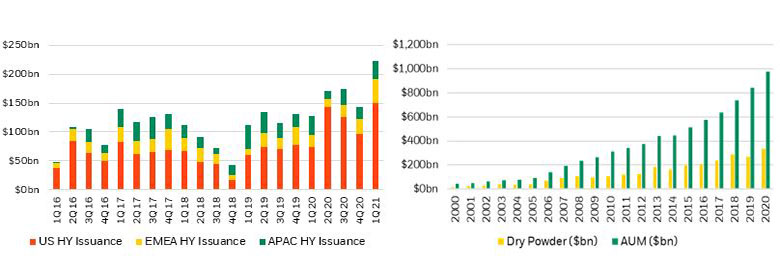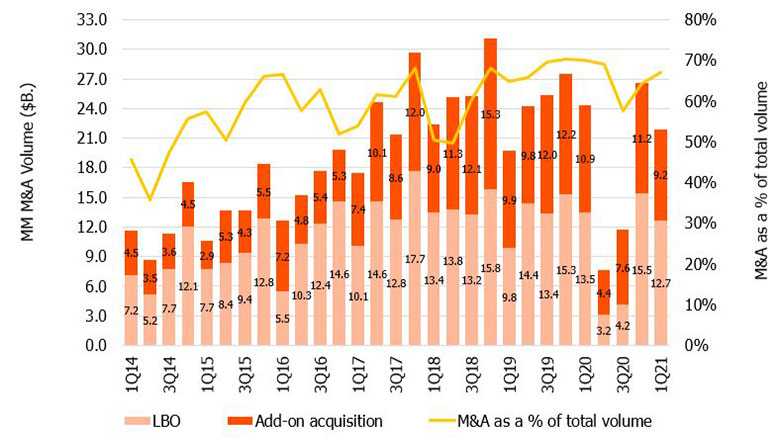Credit’s next chapter
Accelerating evolution
Investing in today’s credit markets is a quest for yield in a rapidly changing landscape. Spreads in liquid markets are at historic tights amid unprecedented central bank support for corporate credit. Industries and business models face disruption from digitization, deglobalization and decarbonization. Sustainability is increasingly important, but not always easy to achieve or measure. The deepening of private credit and the growth of SPACs (special purpose acquisition companies) signal shifts in the symbiosis of public and private markets.
The years following the global financial crisis were transformative ones for today’s credit markets. We think the years ahead will prove equally consequential, as some trends from the prior period speed up and newer trends take hold.
What we expect
Global growth: the sequel
The highest growth rates are likely to be in all types of credit outside the US and within private credit globally.
Financing change
We look for credit markets to serve a spectrum of company needs, from M&A to restructuring.
Innovation and integration
We see mutual benefits for companies and capital providers in a life-cycle approach to credit provision.
Global growth: the sequel
Global high yield issuance was a record US$222 billion in the first quarter of 2021, according to BlackRock Capital Markets, on a path to surpass 2020’s record-breaking tally of US$617 billion.1 Private credit is also seeing a major influx of capital, with AUM of US$975 billion as of September 2020, according to Preqin.2 This continues the expansion of the post-GFC years, which was significant but far more gradual.
Looking ahead, the highest growth rates are likely to be in all types of credit outside the US and within private credit globally. This would continue the trends of the past decade—notably, markets stepping in to lend as banks pull back for regulatory reasons. But there are some key, post-pandemic differences. The leading country in the future global expansion is sure to be China, where relying less on banks and more on markets is a policy priority and the market is potentially as large as North America’s and Europe’s combined. As for private credit, 2020 was a stress test for this still-young asset class, and it passed comfortably. The potential for resilience as well as a yield pickup over traded credit are likely to enhance its appeal to investors.
Significant expansion
Global high yield issuance (left) and private credit demand (right)

Sources: BlackRock Capital Markets, March 2021; Preqin, September 2020.
Financing change
The pandemic has sorted companies into haves and have-nots, depending on their industry, size and business model. We look for credit markets to serve the entire spectrum.
Central bank support has prevented the wave of defaults many expected lockdowns would generate. In April Fitch Ratings lowered its leveraged loan default rate forecast for 2021 to 2.5%, far below the 14% rate seen in 2009.3 However, Fitch also forecast a slightly higher rate of up to 3.5% in 2022, and this is significant.4
For every company that actually defaults, many more face operational or balance sheet problems that are significant but solvable. Looking ahead we expect to see many companies in the latter category, even amid economic growth and easy financial conditions. Often, the reason will be some combination of leverage and a need to adapt to one or more of the powerful changes the pandemic has accelerated. A retailer needing to build out e-tailing capacity or a manufacturer re-engineering its supply chain are cases in point. Credit, particularly private credit, plays a growing role in financing this type of transformation.
Meanwhile, amid growing economic optimism, credit markets are ramping up their traditional role of financing M&A, as indicated in the chart below, which shows private middle market loans used for the purpose.
For every company that actually defaults, many more face operational or balance sheet problems that are significant but solvable.
Acquisitions accelerate
Quarterly middle-market sponsored M&A issuance

Source: Refinitiv, March 2021.
Innovation and integration
As credit markets expanded over the past decade, the different segments focused on different kinds of issuers. High yield became a market serving larger companies able to meet the standards of an investor base that has grown more institutional over time. Smaller issuers with more complex stories increasingly looked to the private credit markets for financing. In today’s growing economy, there is a widening gap between commercial bank financing at one end of the spectrum and the syndicated leverage finance market at the other, providing further opportunities for private credit. And while this trend started in the US, it is now accelerating in Europe and Asia.
Where segmentation of the overall market was a theme in the last decade, we expect integration to be a hallmark of the next one. As private debt managers have attracted more capital, direct lenders have taken on increasingly large transactions, with Preqin counting six deals over US$1 billion in 2020.5 Given the available scale, some issuers that could access syndicated markets are opting for private debt (paying a premium for certainty of execution and/or discretion) or using both.
We also see mutual benefits for companies and capital providers in a life-cycle approach to credit provision. Companies needing a venture loan to fund growth, or a bespoke solution to a financing challenge, will (if all goes well) often go on to tap liquid markets. Conversely, a high yield issuer with a financing challenge may turn to private markets for a solution.






